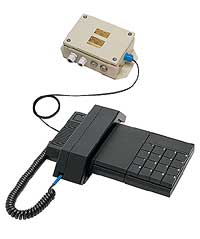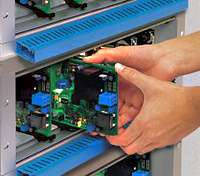

The telephone system consists of an intrinsically safe desk or wall-mounted telephone and a stand-alone or rackmountable barrier (see fig. 1). The telephone can be connected to an analogue public telephone network or a private branch exchange. The desk or wall-mounted telephone is designed for use in areas with group II explosive atmospheres. Every desk or wallmounted telephone is connected to a barrier with a interchangable two-wire cable (max. cable length approx. 500 m). The desk or wall-mounted telephone is supplied with power by the corresponding barrier via this connection cable. This power supply is intrinsically safe and an additional power supply to the telephone is not necessary. The barrier separates the non intrinsically safe part of the circuit from the intrinsically safe part. If the stand-alone or rack-mountable barrier is connected within a private branch exchange, the DC supply voltage of 45 – 63 V of the branch exchange can also be used for the barrier. If the single-line or rackmountable barrier is installed outside the branch exchange and there is no DC supply voltage available for the barrier, the barrier can be powered by the 230 V mains. If both supply voltages are connected at the same time, the barrier is supplied solely from the 230 V mains, thereby sparing the DC source. If, however, the mains power supply fails, the device is automatically switched over to DC power supply. The stand-alone and rack-mountable barriers are equipped with an additional contact (marking: W, W 1), with which an external device (e.g. a secondary ringer) can be operated. If several desk or wall-mounted telephones are used together, a rack-mountable barrier installed in a 19" assembly rack is recommended. The rack can be equipped with a maximum of seven rack-mountable barriers. The 19" rack must be installed in a cubicle with at least protection degree IP 20 and may only be set up outside the hazardous area.